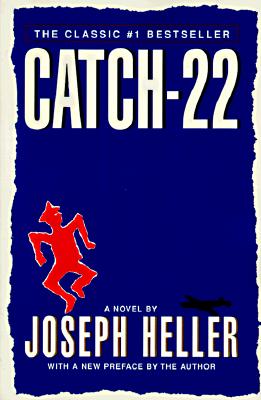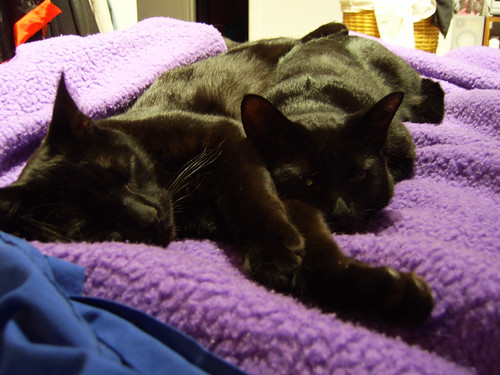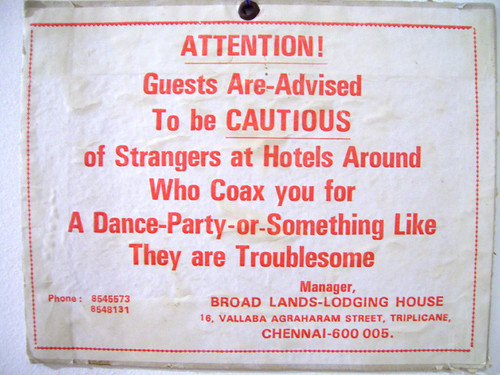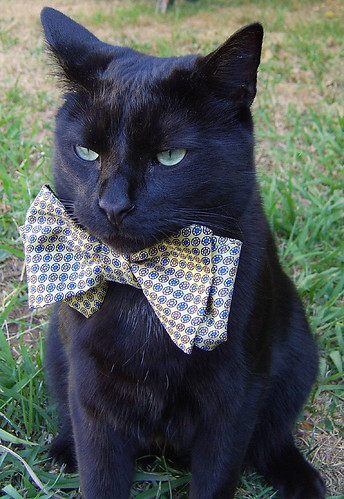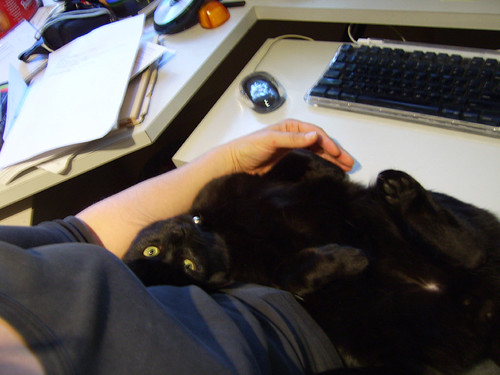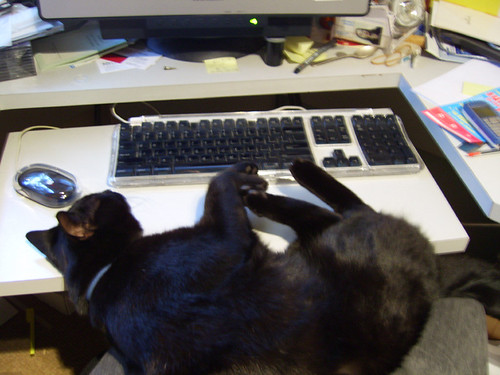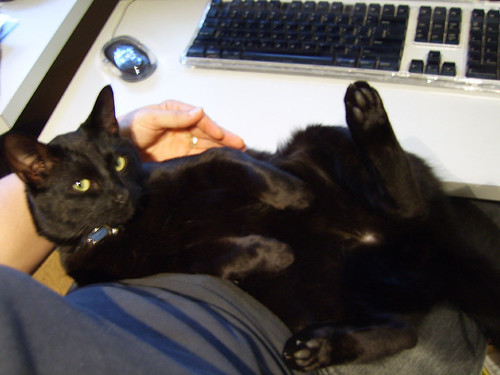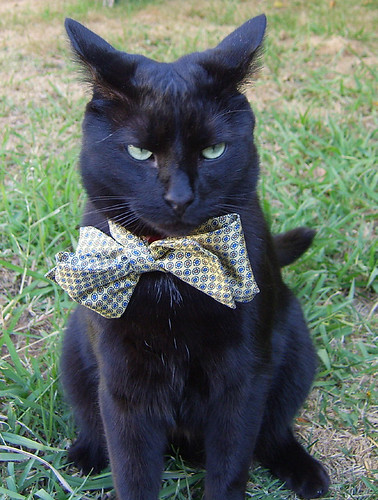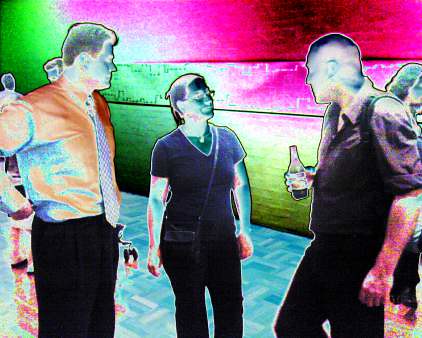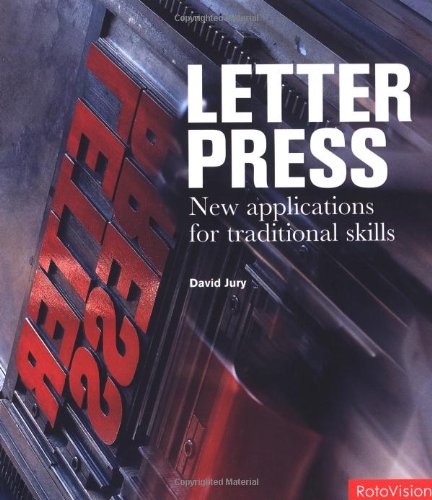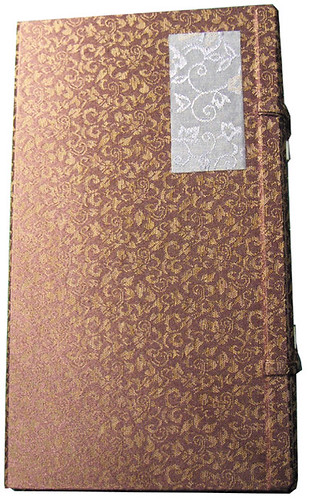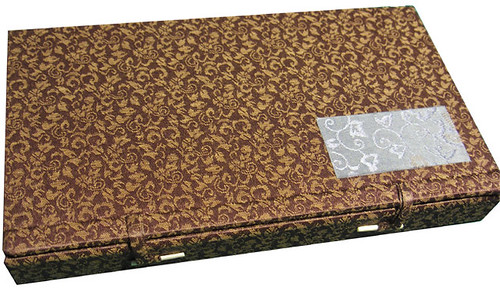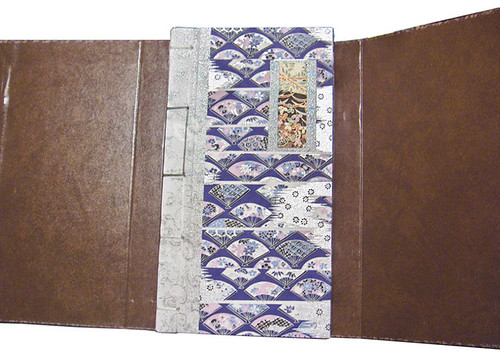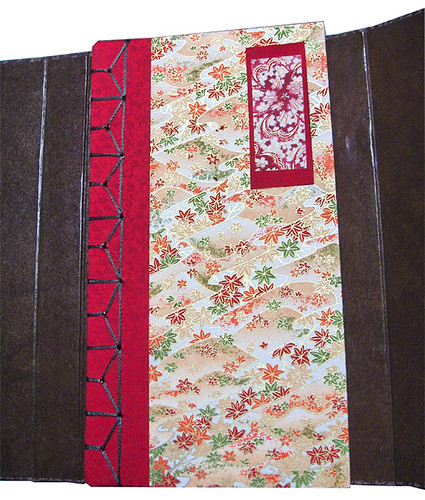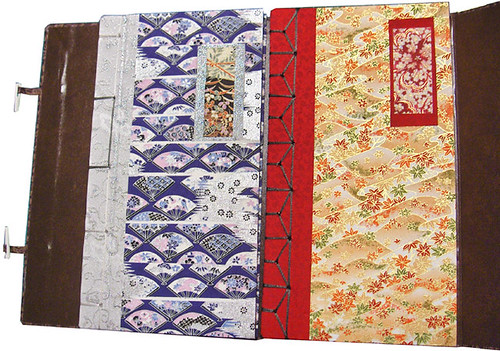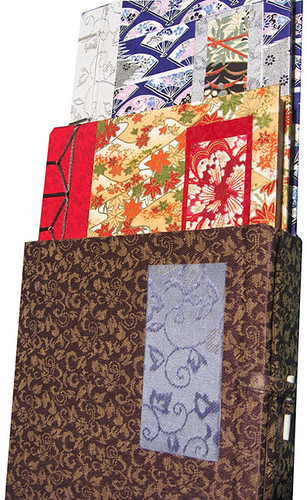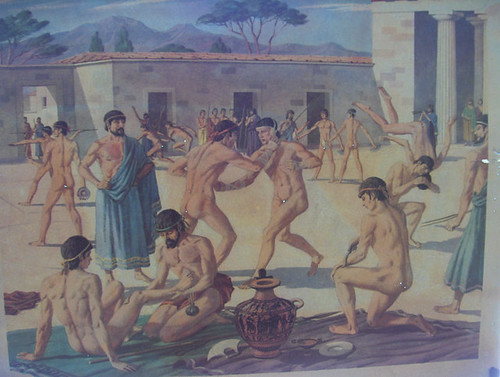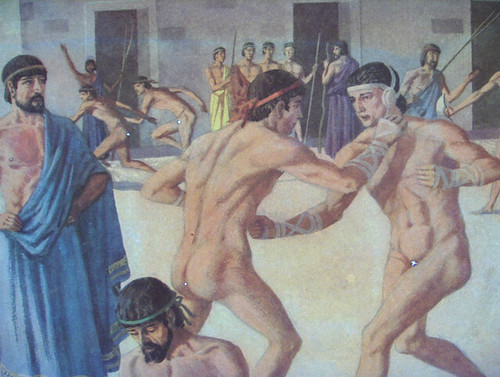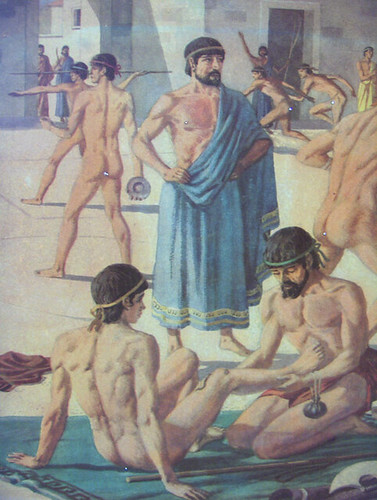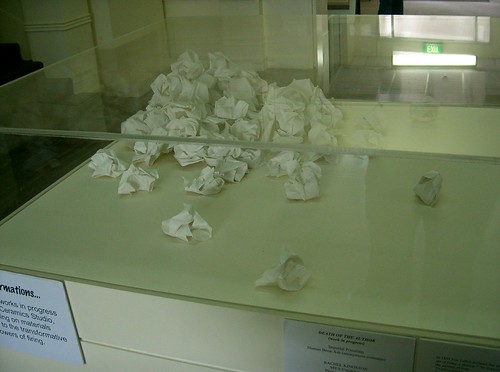The Studio I work in (I'm going to start calling it the BookStud, heh) is hosting two visiting international artists at the moment. Both of them were invited to Australia for the
Mackay Artist Book Forum and had these residencies arranged for them as part of the Mackay festivities. I didn't get to go to Mackay this year, and I'm very sorry about that. It sounded terrific. If anyone reading this went, let me know all about it.
I had met both of these artists when I was in Korea for the International Bookarts Fair in 2004, and since I have no camera I'm going to punctuate this post with images from that trip. It was a great experience, and I'm sorry I saw no more than the city itself. If I ever go back I want to travel around the countryside.
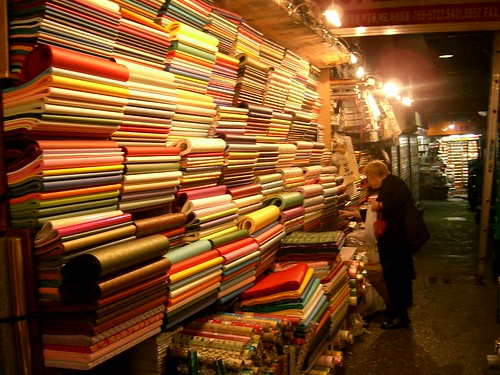 This is a paper shop at one of Seoul's fantastic markets. We went at night because our days were so full of other commitments. Picking out paper like fabric is a wonderful experience. Unfortunately I had very little money, so my colleague in the picture had all the fun.
This is a paper shop at one of Seoul's fantastic markets. We went at night because our days were so full of other commitments. Picking out paper like fabric is a wonderful experience. Unfortunately I had very little money, so my colleague in the picture had all the fun.Anyhoo, the first visiting artist is a bookarts artist from Korea, whom I met when we went to the Bookarts Fair -- in fact, she organised the whole thing. She is very sweet, keen to promote book arts wherever she goes. She is teaching a masterclass this weekend with some Canberra bookbinders: I'm going to be technical helper, which means I get to learn by watching but not do, mostly because I'll be preparing food and running around cutting up paper etc.
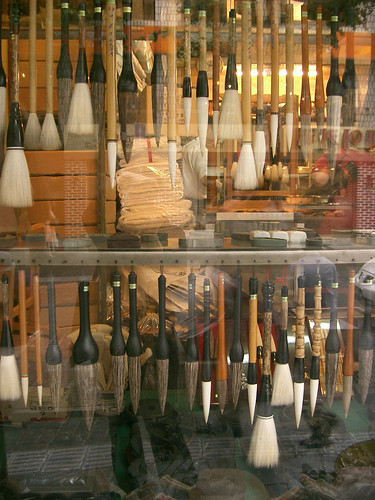 A Seoul brush shop in Insadong (sp?), the arts quarter of Seoul. Such a great area, full of galleries, restaurants and art supplies. These brushes are made from all sorts of bristles and furs (sorry, vegans) and they will advise you on the best kind of brush for particular purposes. My colleague had a great lecture from them on the difference between Korean weasel fur and Vietnamese weasel fur.
A Seoul brush shop in Insadong (sp?), the arts quarter of Seoul. Such a great area, full of galleries, restaurants and art supplies. These brushes are made from all sorts of bristles and furs (sorry, vegans) and they will advise you on the best kind of brush for particular purposes. My colleague had a great lecture from them on the difference between Korean weasel fur and Vietnamese weasel fur.I introduced her to the concept of polymer plate printing this week, and she's trying desperately to complete a huge book printing project based on the Chinese zodiac, combining wood engraving, letterpress and polymer plate... I'm trying to help her finish it, but as her schedule fills up the likelihood of completion gets smaller. She's leaving on Friday week, and people keep doing horrendous things to her like taking her to markets, down the coast, and out to dinner. I guess she's going to have to finish some of it at home.
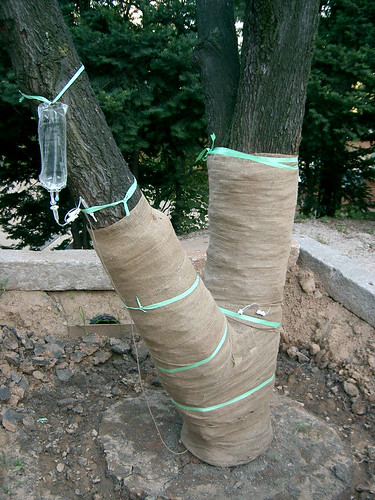 Koreans love trees. Ages ago I blogged a photo showing a very ancient Korean tree with only one living branch, which was lovingly propped up with an amazing scaffold. (No time to find it now, you can trawl through my archives at your leisure.) This tree was at a Buddhist temple, and as you can see, it's getting some extreme TLC. Yes, that is an intravenous drip going into its limb on the left!
Koreans love trees. Ages ago I blogged a photo showing a very ancient Korean tree with only one living branch, which was lovingly propped up with an amazing scaffold. (No time to find it now, you can trawl through my archives at your leisure.) This tree was at a Buddhist temple, and as you can see, it's getting some extreme TLC. Yes, that is an intravenous drip going into its limb on the left!The other artist visiting is a New Yorker who was also a guest artist at the Seoul Book Fair. He is part of the Booklyn Artists Alliance, who try to flog their art as a collective, cutting out the middle dealer types. MW is a ball of energy, and he describes himself as an activist artist. A lot of his work (and of course he's a mult-i media artist) revolves around ish-ews of linguistics, human rights, the environment, and peace. His pet subject is the rights of indigenous peoples around the world. He has been raising some hackles in the art school because, while he says some very interesting things, he does so in such a didactic and superior way that he sort of undoes all the political goodness in his words.
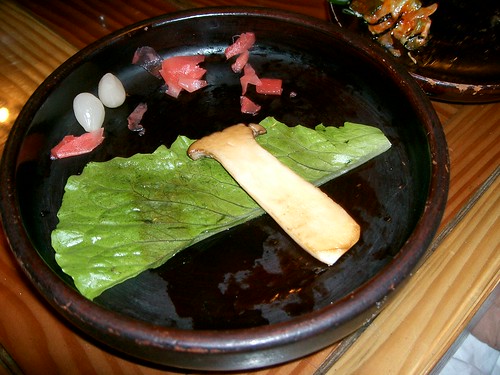 This was a great restaurant that had traditional Korean dancers, and while you were admiring their fabulous costumes and graceful moves you were brought fabulous little courses with graceful compositions. This, of course, is a mushroom. It was superb.
This was a great restaurant that had traditional Korean dancers, and while you were admiring their fabulous costumes and graceful moves you were brought fabulous little courses with graceful compositions. This, of course, is a mushroom. It was superb.I found that aspect of him very interesting today. He gave a short introduction to himself to the printing students and then a couple of hours later gave a more formal lecture to the school and the public. He was talking a lot about his present project, which is doing
frottage, or rubbings, of war memorials and commemorative plaques in both small country towns and major Australian cities, and rearranging the wording to invert the messages and make clear liberal political statements. For example, he prefaces a lot of the works with the statement WE FORGET (dropping the LEST) and then mixes the usual messages. So a work might read like this:
WE FORGET
the sacrifice
to the war effort
made by the Aboriginal people
for an ungrateful nation
and a fearful Empire
Something like that, anyway. All rubbed in red and black wax crayon on Mylar or handmade paper.
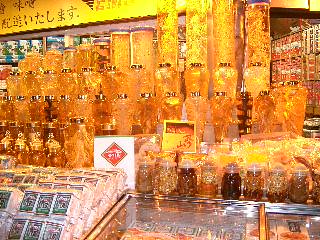 Huge quantities of ginseng in jars at a market shop in Seoul. The shop was called Seoul Food. Noice.
Huge quantities of ginseng in jars at a market shop in Seoul. The shop was called Seoul Food. Noice.All good and well. I like this work. But then he got up and started talking to us about the Civil War in Australia and how we've ignored the role that the Aboriginal military resistance has played in our history. And that's when I noticed all the arms and legs in the room begin to cross. And the air chilled a bit. I don't think that it was a resistance to the idea that the Aboriginal people have been suppressed and this needs to be redressed -- it was innate Australian umbrage that an American was standing up in front of us telling us something that he obviously didn't
really know a lot about. He was treating it like another card in his Oppressed Indigenous Peoples of the World Pack, and he was proud that he'd collected the whole set. He was taking a moral high ground, and everyone in the room didn't accept that from an American. Even someone who professes to be as leftie and anti-establishment as he did.
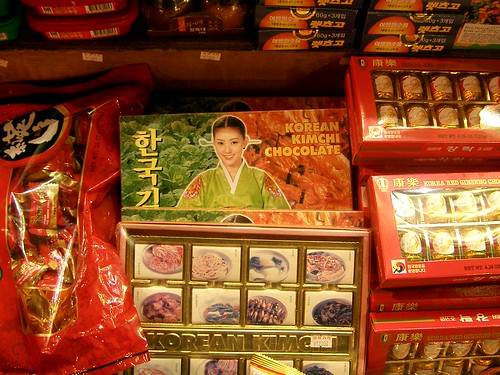 This is something hard to swallow. It's kim chi chocolate. For those who don't know what kim chi is: extremely salty pickled vegetables. Not tangy like saurkraut, just salty. They also have kim chi icecream. I suspect both items exist to tease tourists.
This is something hard to swallow. It's kim chi chocolate. For those who don't know what kim chi is: extremely salty pickled vegetables. Not tangy like saurkraut, just salty. They also have kim chi icecream. I suspect both items exist to tease tourists.Anyway, I feel a bit sorry for these two artists, because they came to the BookStud expecting it to be like last year, when we played with people who didn't have printmaking skills and helped them produce something new in their artistic practice. But the person who
enforceddeveloped that program has now retired, and we are in a new era of providing a facility, not a service. So they only get 2 full days of me a week, and the rest of the time they have to work on their own.
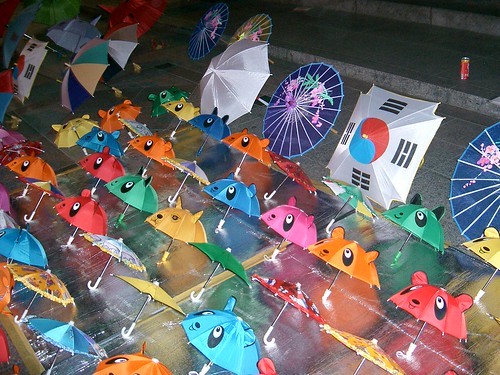 Umbrellas on a street stall, Seoul
Umbrellas on a street stall, SeoulActually, it hasn't worked like that precisely because I do feel sorry for them. Even on my days off I try to pop in and make sure they're ok, which usually spins out alarmingly and I end up running around for them for hours. But I don't like the idea of them going home disappointed. Doesn't help the stress levels, but it's only for two weeks. After that the BookStud gets much groovier, and I'm looking forward to reporting some of the funky stuff we've got planned. I'm hoping we'll publish a zine sometime this year, using letterpress. Can't wait.
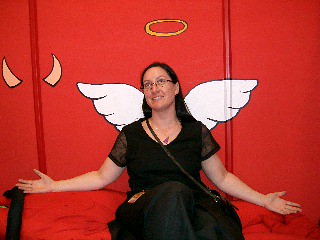 Breaking a personal rule here, but I love this photo. I'm kicking myself for not posing with the accompanying devil's bits (you can see them on the left). Yes, this is Ducky Angel (still in Seoul!). Doing my best to keep everyone happy...
Breaking a personal rule here, but I love this photo. I'm kicking myself for not posing with the accompanying devil's bits (you can see them on the left). Yes, this is Ducky Angel (still in Seoul!). Doing my best to keep everyone happy...PS Just went on a lovely picnic by the Lake to celebrate International Women's Day. 6 women of varying ages, sitting on the little island which holds the
Carillion. The carillion played (we joked about asking the keyboard player to give us a rousing rendition of 'I am Woman', but we chickened out), someone did an art performance which we videoed for her PhD, and we ate scrummy things while the sun set. Canberra is lovely this time of year.
TAGS: memorials, bookarts, Seoul, International Women's Day
